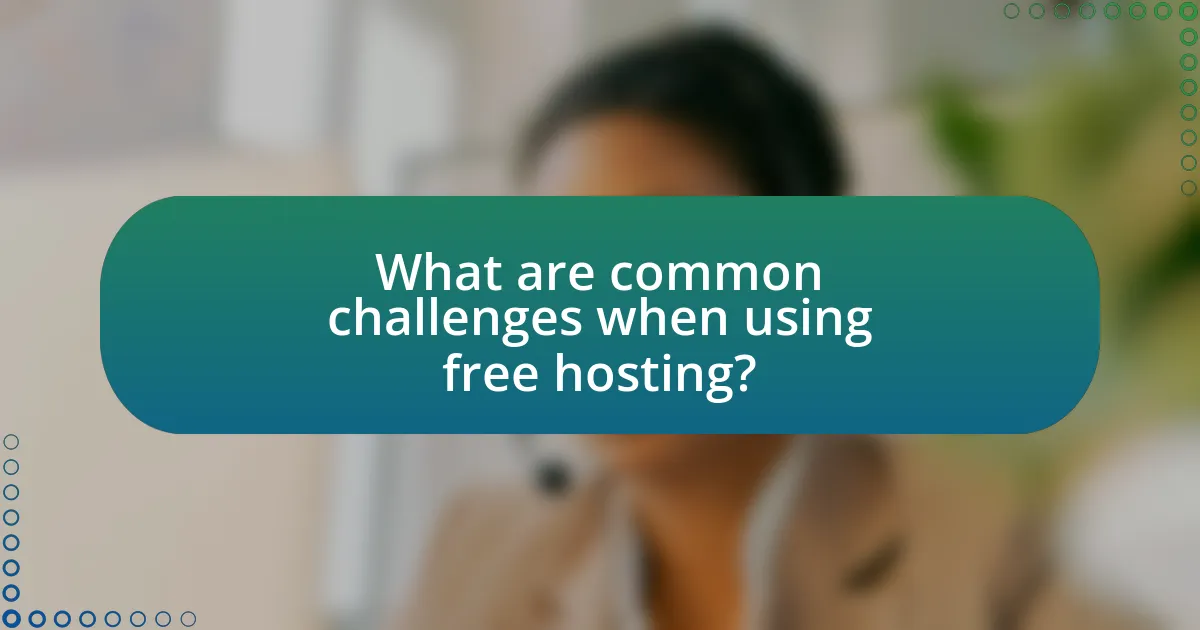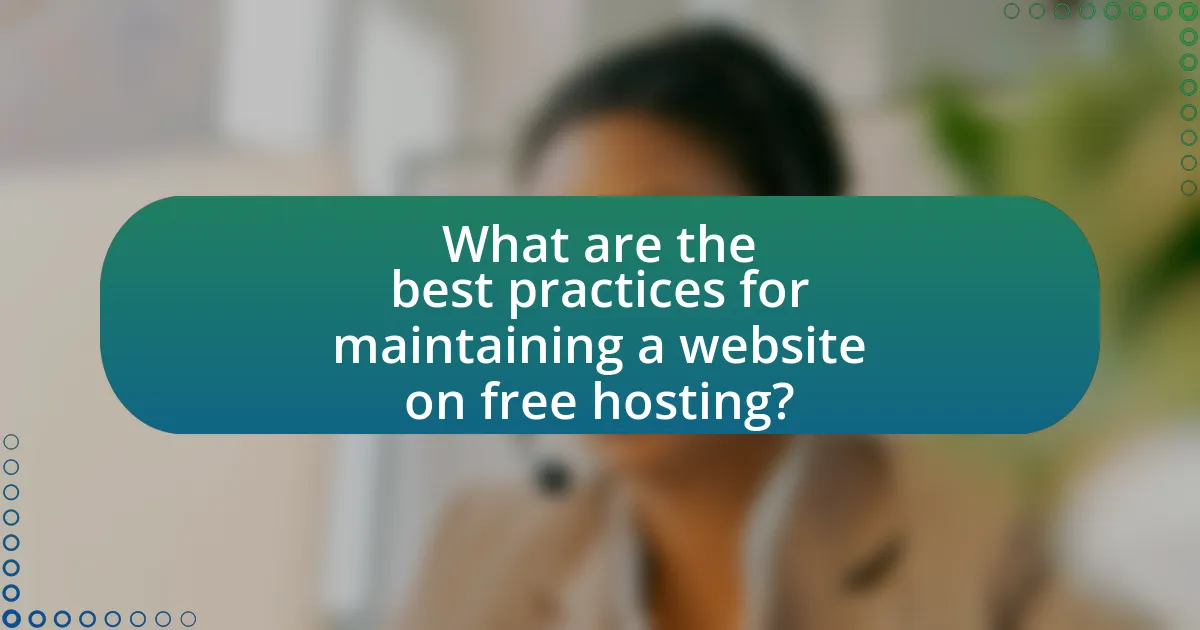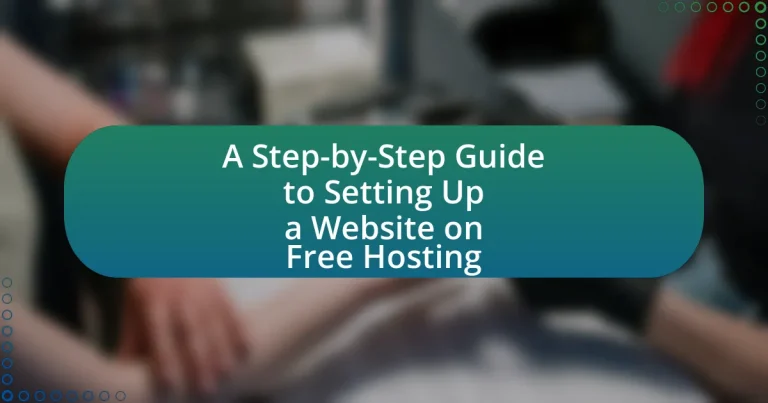A website on free hosting allows users to create and publish content online without financial investment, typically offering limited resources and features. This article provides a comprehensive guide on setting up a website using free hosting services, detailing the differences between free and paid hosting, the limitations of free services, and the advantages they offer. It outlines the steps for selecting a provider, registering an account, building a website, and optimizing performance while addressing common challenges and best practices for maintenance. Additionally, it highlights strategies for promoting the website and resources for further learning about website management.

What is a Website on Free Hosting?
A website on free hosting is a website that is hosted on a server without any cost to the user. These platforms typically provide basic features and limited resources, allowing individuals or small businesses to create and publish their content online without financial investment. Free hosting services often come with restrictions such as limited storage, bandwidth, and the presence of advertisements, which can affect the user experience and website performance.
How does free hosting differ from paid hosting?
Free hosting differs from paid hosting primarily in terms of features, reliability, and support. Free hosting typically offers limited storage, bandwidth, and functionality, often displaying ads on user websites, while paid hosting provides more resources, enhanced performance, and customer support. For instance, paid hosting services often include features like custom domain names, SSL certificates, and better security measures, which are generally absent in free hosting options. Additionally, according to a 2021 survey by HostingAdvice, 70% of users reported that paid hosting resulted in faster website loading times and improved uptime compared to free hosting services.
What are the limitations of free hosting services?
Free hosting services have several limitations, including restricted storage space, limited bandwidth, and lack of customer support. These services often impose caps on the amount of data that can be stored and transferred, which can hinder website performance and accessibility. Additionally, free hosting typically includes advertisements on users’ sites, reducing professionalism and user experience. Security features are often minimal, leaving websites vulnerable to attacks. Furthermore, users may not have access to custom domain names, which can affect branding and credibility. These limitations can significantly impact the functionality and growth potential of a website hosted on a free service.
What features are typically offered by free hosting providers?
Free hosting providers typically offer features such as limited storage space, bandwidth, and subdomain usage. These providers often include basic website builders, email accounts, and support for popular content management systems like WordPress. Additionally, free hosting services may display advertisements on hosted sites and provide limited customer support. According to a survey by HostingAdvice, 70% of free hosting users reported satisfaction with the basic features, although they acknowledged the constraints compared to paid options.
Why would someone choose free hosting for their website?
Someone would choose free hosting for their website primarily to save costs. Free hosting services allow individuals and small businesses to establish an online presence without financial investment, making it accessible for those with limited budgets. According to a survey by HostingAdvice, approximately 30% of new website owners opt for free hosting to test their ideas before committing to paid services. This approach enables users to experiment with website design and functionality without incurring expenses, which is particularly beneficial for startups and personal projects.
What are the advantages of using free hosting?
The advantages of using free hosting include cost savings, ease of access, and basic functionality for small projects. Free hosting allows users to create and maintain a website without financial investment, making it ideal for individuals or small businesses testing ideas or learning web development. Additionally, many free hosting services offer user-friendly interfaces and templates, enabling quick setup and management. According to a survey by HostingAdvice, over 60% of users choose free hosting for its affordability and simplicity, demonstrating its appeal for those with limited resources or technical expertise.
Who is the ideal audience for free hosting services?
The ideal audience for free hosting services includes individuals, small businesses, and hobbyists who seek to establish an online presence without incurring costs. These users typically have limited budgets and may be testing ideas, launching personal projects, or learning web development. According to a survey by HostingAdvice, 70% of new website owners prefer free hosting options to minimize initial expenses while exploring their online ventures.

What are the steps to set up a website on free hosting?
To set up a website on free hosting, follow these steps: First, choose a free hosting provider such as WordPress.com, Wix, or GitHub Pages. Next, create an account with the selected provider by providing necessary information like email and password. After account creation, select a template or theme that suits your website’s purpose. Then, customize the website by adding content, images, and any desired features using the provider’s editing tools. Finally, publish the website by clicking the appropriate button, making it accessible to the public. These steps are validated by the common practices of popular free hosting platforms, which guide users through similar processes.
How do you select the right free hosting provider?
To select the right free hosting provider, evaluate key factors such as reliability, storage limits, bandwidth, and customer support. Reliable providers typically have a proven track record of uptime, often exceeding 99.9%, which is crucial for maintaining website accessibility. Storage limits should meet your website’s needs; many free hosts offer between 1GB to 10GB, which is sufficient for small projects. Bandwidth is also important, as it determines how much traffic your site can handle; look for providers that offer unlimited or high bandwidth options. Lastly, assess customer support availability, as responsive support can help resolve issues quickly, enhancing your overall experience.
What criteria should you consider when choosing a provider?
When choosing a provider for free hosting, consider reliability, features, customer support, and user reviews. Reliability ensures that your website remains accessible, with uptime guarantees typically above 99%. Features such as storage space, bandwidth, and website builders can significantly impact your site’s performance and ease of use. Customer support is crucial; providers should offer responsive assistance through various channels like chat or email. User reviews provide insights into the experiences of others, helping to gauge the provider’s overall reputation and service quality.
Which popular free hosting services are available?
Popular free hosting services include WordPress.com, Wix, Weebly, and GitHub Pages. WordPress.com offers a user-friendly platform with customizable templates, while Wix provides drag-and-drop features for easy website creation. Weebly is known for its simplicity and e-commerce capabilities, and GitHub Pages allows users to host static websites directly from their GitHub repositories. These services are widely used due to their accessibility and range of features, making them suitable for individuals and small businesses looking to establish an online presence without incurring costs.
What are the initial steps to create your website?
To create your website, the initial steps include selecting a domain name, choosing a web hosting service, and setting up a content management system (CMS). Selecting a domain name involves brainstorming a unique and relevant name that reflects your website’s purpose, followed by registering it through a domain registrar. Choosing a web hosting service requires comparing options based on features, reliability, and user reviews; many free hosting services are available for beginners. Finally, setting up a CMS, such as WordPress, allows for easy website management and content creation, as it provides user-friendly tools and templates. These steps are foundational for establishing an online presence effectively.
How do you register for a free hosting account?
To register for a free hosting account, visit the website of a hosting provider that offers free plans, such as InfinityFree or 000webhost. After selecting the free hosting option, fill out the registration form with your email address and create a password. Once you submit the form, you will typically receive a confirmation email to verify your account. Following the verification, you can log in to your new account and start setting up your website. This process is standard across many free hosting services, ensuring accessibility for users looking to establish an online presence without initial costs.
What information do you need to provide during registration?
During registration, you typically need to provide personal information such as your name, email address, and a password. This information is essential for creating an account and ensuring secure access to the hosting services. Additionally, some platforms may require you to confirm your email address to verify your identity, which is a common practice to enhance security and prevent fraudulent registrations.
How do you build your website once hosting is set up?
To build your website once hosting is set up, you need to select a website builder or content management system (CMS) that suits your needs. Popular options include WordPress, Wix, and Squarespace, which provide user-friendly interfaces and templates. After choosing a platform, you can customize your website by selecting a theme, adding pages, and incorporating content such as text, images, and videos.
For instance, WordPress powers over 40% of all websites, demonstrating its effectiveness and popularity. Once your design is complete, you can publish your site, making it accessible to visitors. This process typically involves clicking a “Publish” button within the website builder interface, confirming that your site is live.
What tools can you use to create your website?
To create your website, you can use website builders like WordPress, Wix, and Squarespace. These tools provide user-friendly interfaces and templates that simplify the website creation process. For instance, WordPress powers over 40% of all websites globally, showcasing its popularity and versatility. Additionally, Wix offers drag-and-drop functionality, making it accessible for users without coding skills. Squarespace is known for its visually appealing designs, catering to creative professionals. Each of these tools supports free hosting options, aligning with the topic of setting up a website on free hosting.
How do you choose a website template or theme?
To choose a website template or theme, first identify the purpose and target audience of your website. This clarity helps in selecting a design that aligns with your content and user expectations. Next, evaluate the template’s responsiveness, ensuring it functions well on various devices, as 54.8% of global website traffic comes from mobile devices according to Statista. Additionally, consider customization options; a flexible template allows for branding and personalization, which is crucial for user engagement. Lastly, check for support and updates from the template provider, as ongoing maintenance is essential for security and functionality.

What are common challenges when using free hosting?
Common challenges when using free hosting include limited storage and bandwidth, lack of customer support, and potential security vulnerabilities. Free hosting services often impose strict limits on the amount of data you can store and the traffic your site can handle, which can lead to performance issues as your website grows. Additionally, many free hosting providers do not offer reliable customer support, making it difficult to resolve technical issues promptly. Security is another concern, as free hosting platforms may not implement robust security measures, leaving websites more susceptible to attacks and data breaches.
What issues might you encounter with free hosting?
Free hosting often presents several issues, including limited storage and bandwidth, which can hinder website performance. Many free hosting services impose strict resource limits, leading to slow loading times and potential downtime during traffic spikes. Additionally, free hosting typically lacks customer support, making it difficult to resolve technical problems promptly. Security vulnerabilities are also common, as free hosts may not provide adequate protection against cyber threats. Furthermore, advertisements are frequently displayed on free-hosted sites, detracting from user experience and brand credibility. These factors collectively make free hosting a less reliable option for serious website projects.
How can you troubleshoot common problems?
To troubleshoot common problems when setting up a website on free hosting, first identify the specific issue, such as connectivity errors, loading problems, or configuration issues. Next, check the hosting provider’s documentation for known issues and solutions, as many providers offer troubleshooting guides tailored to their services. Additionally, verify that all domain settings, such as DNS records, are correctly configured, as incorrect settings can lead to accessibility problems. For example, a misconfigured DNS can prevent users from reaching the website, which is a common issue. Finally, utilize online forums or support communities related to the hosting service, as they often contain valuable insights from other users who have faced similar problems.
What are the best practices to avoid downtime?
To avoid downtime, implement regular backups, utilize a reliable hosting provider, and monitor server performance continuously. Regular backups ensure that data can be restored quickly in case of failure, while a reliable hosting provider minimizes the risk of outages due to their infrastructure and support. Continuous monitoring of server performance allows for the early detection of issues, enabling proactive measures to be taken before they lead to downtime. According to a study by Gartner, companies that invest in robust IT infrastructure and monitoring can reduce downtime by up to 50%.
How can you optimize your website on free hosting?
To optimize your website on free hosting, focus on minimizing resource usage and enhancing performance. Utilize lightweight themes and optimize images to reduce loading times, as faster websites improve user experience and search engine rankings. Implement caching techniques, such as browser caching and content delivery networks (CDNs), to further enhance speed. Additionally, regularly update your content and plugins to ensure security and functionality, as outdated components can lead to vulnerabilities and performance issues. These strategies are essential because studies show that a one-second delay in page load time can lead to a 7% reduction in conversions, highlighting the importance of optimization for user retention and engagement.
What strategies can improve website performance?
To improve website performance, optimizing images is essential, as large image files can significantly slow down loading times. Compressing images using tools like TinyPNG or ImageOptim can reduce file sizes without sacrificing quality, leading to faster page loads. Additionally, implementing browser caching allows frequently accessed resources to be stored locally on users’ devices, which decreases load times for returning visitors. According to Google, effective caching can improve load times by up to 60%. Furthermore, minimizing HTTP requests by combining CSS and JavaScript files reduces the number of requests made to the server, enhancing performance. Research from the HTTP Archive indicates that reducing the number of requests can lead to a 20-30% improvement in load times. Lastly, utilizing a Content Delivery Network (CDN) distributes website content across multiple servers globally, ensuring faster access for users regardless of their location. Studies show that CDNs can reduce latency by up to 50%.
How do you enhance security on a free hosting platform?
To enhance security on a free hosting platform, implement strong password policies and enable two-factor authentication. Strong passwords reduce the risk of unauthorized access, while two-factor authentication adds an extra layer of security by requiring a second form of verification. According to a study by Google, two-factor authentication can block 99.9% of automated attacks, demonstrating its effectiveness in safeguarding accounts. Additionally, regularly updating software and plugins helps patch vulnerabilities, further securing the hosting environment.

What are the best practices for maintaining a website on free hosting?
The best practices for maintaining a website on free hosting include regularly updating content, optimizing for performance, and ensuring security. Regularly updating content keeps the website relevant and engaging, which can improve user retention and search engine rankings. Optimizing for performance involves minimizing load times by compressing images and using efficient coding practices, as studies show that a one-second delay in page load time can lead to a 7% reduction in conversions. Ensuring security is crucial, as free hosting services may not provide robust security measures; therefore, implementing basic security practices like using strong passwords and regularly backing up data is essential to protect against data loss or breaches.
How often should you update your website content?
You should update your website content at least once every few months to maintain relevance and improve SEO performance. Regular updates signal to search engines that your site is active, which can enhance your rankings. According to a study by HubSpot, companies that blog regularly receive 97% more links to their websites, indicating that fresh content attracts more visitors and backlinks. Additionally, updating content can help keep your audience engaged and informed, fostering loyalty and repeat visits.
What types of content should you prioritize for updates?
You should prioritize updating content that is time-sensitive, such as tutorials, guides, and FAQs related to free hosting services. This type of content is crucial because it directly impacts user experience and the accuracy of information provided. For instance, if a free hosting provider changes its features or policies, updating the relevant guides ensures users have the most current and useful information. Additionally, updating content that receives high traffic can improve SEO performance, as search engines favor fresh and relevant content.
How can regular updates benefit your website’s visibility?
Regular updates enhance a website’s visibility by improving its search engine ranking and user engagement. Search engines prioritize fresh content, which means that websites that are regularly updated are more likely to appear higher in search results. According to a study by HubSpot, websites that publish blog posts frequently receive 97% more links to their content, which further boosts their visibility. Additionally, updated content keeps users engaged, leading to longer visit durations and lower bounce rates, both of which are positive signals to search engines.
What tips can help you succeed with free hosting?
To succeed with free hosting, choose a reliable provider that offers sufficient bandwidth and storage. Reliable providers, such as InfinityFree or 000webhost, ensure uptime and performance, which are critical for user experience. Additionally, optimize your website for speed and efficiency by minimizing image sizes and using caching techniques, as faster loading times can significantly improve user retention and search engine rankings. Regularly back up your website data, as free hosting services may not provide automatic backups, reducing the risk of data loss. Lastly, engage with your audience through social media and email marketing to drive traffic to your site, as building a user base is essential for success.
How can you effectively promote your website?
To effectively promote your website, utilize a combination of search engine optimization (SEO), social media marketing, and content marketing. SEO enhances your website’s visibility on search engines, driving organic traffic; for instance, optimizing for relevant keywords can increase your site’s ranking, leading to a potential increase in visitors by up to 14.6% compared to traditional outbound methods, which only yield a 1.7% success rate. Social media marketing allows you to engage with a broader audience, as platforms like Facebook and Instagram have billions of active users, providing a vast potential reach. Content marketing, through blogs or videos, establishes authority and attracts visitors; research shows that companies that prioritize blogging are 13 times more likely to see a positive ROI. By integrating these strategies, you can create a comprehensive promotional plan that effectively increases your website’s traffic and visibility.
What resources are available for learning more about website management?
Comprehensive resources for learning about website management include online courses, tutorials, and documentation. Platforms like Coursera and Udemy offer structured courses on website management, covering essential topics such as content management systems, SEO, and analytics. Additionally, websites like W3Schools and Mozilla Developer Network provide extensive tutorials and documentation on web technologies and best practices. These resources are widely recognized for their quality and are frequently updated to reflect current trends and technologies in website management.




